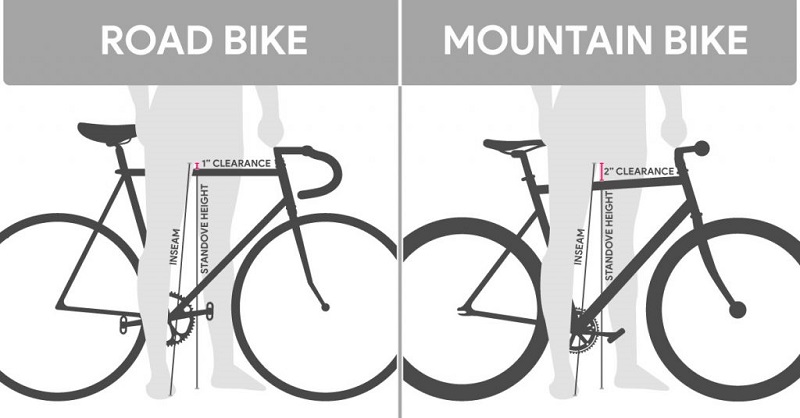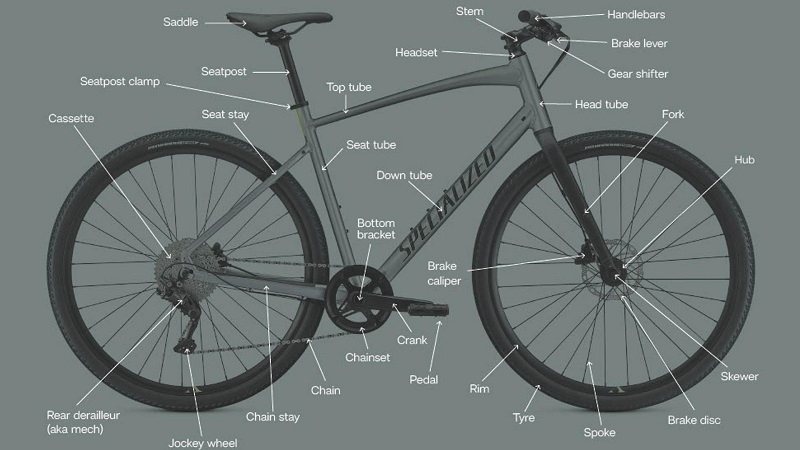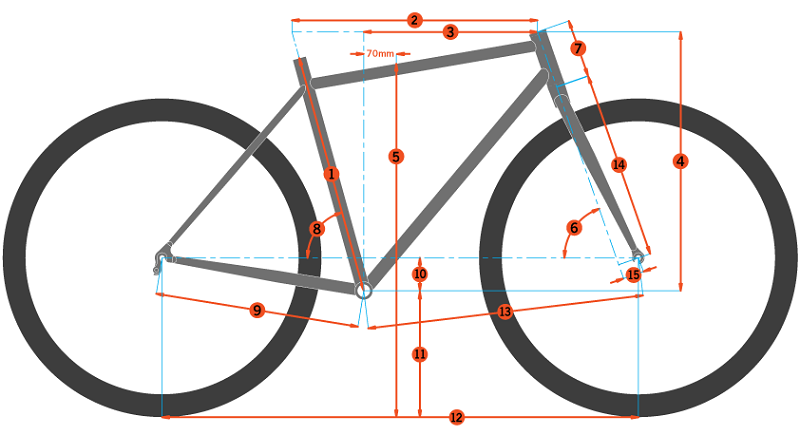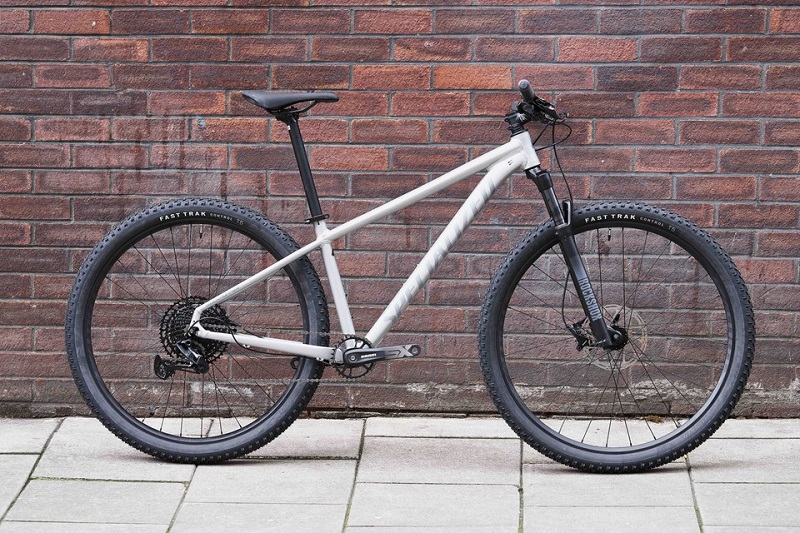Tips
What Are Bike Frame Sizes?
Choosing the correct bike frame size is crucial for both beginners and experienced cyclists. Riding a bike that doesn’t fit properly can lead to discomfort, reduced efficiency, and even injuries. This article aims to shed light on the what are bike frame sizes, intricacies of bike frame sizes and how to determine the right fit for every individual.
What Are Bike Frame Sizes?
Bike frame sizes refer to the size of the bicycle frame, which is essential for ensuring a comfortable and efficient ride for the cyclist. Choosing the right frame size is critical to your riding comfort, safety, and overall cycling performance. The method of measuring and the terminology can vary between types of bicycles and even between manufacturers, but here are some general guidelines:
Road Bikes
These are often sized in centimeters (e.g., 50cm, 54cm, 58cm, etc.), which typically measures the length of the seat tube – from the center of the bottom bracket to the top of the seat tube. However, some manufacturers might measure to the center of the top tube intersection.
Mountain Bikes
These are typically sized in inches (e.g., 15″, 17″, 19″, etc.), and this measurement again often refers to the length of the seat tube. However, with the advent of more advanced and varied mountain bike designs, many companies now use Small, Medium, Large, etc., as their sizing metric.

Hybrid Bikes
These can be sized similarly to road or mountain bikes. They might come in centimeters, inches, or Small/Medium/Large designations.
BMX Bikes
These typically come in wheel diameter sizes (e.g., 20-inch) rather than frame size because they’re designed to have a lot of overlap in terms of rider size. However, top tube length can be a distinguishing factor for more precise sizing.
Touring Bikes, Commuters, and Others
These can vary but are often sized similarly to road or mountain bikes.
Children’s Bikes
Usually sized by wheel diameter (e.g., 12″, 14″, 16″, 20″, 24″).
Remember that after finding the right frame size, other adjustments (saddle height, saddle position, handlebar height, etc.) can be made to fine-tune the fit. If in doubt, always consult with a local bike shop or an experienced cyclist to guide you in choosing the correct size.
Why Frame Size Matters?
Frame size plays a fundamental role in the overall cycling experience for several reasons:
Comfort: A bike that’s too big or too small can cause discomfort, leading to aches and pains in various parts of the body. If you’re constantly stretching to reach the handlebars or if your knees are too close to them, long rides can become agonizing.
Efficiency: Riding a bike that fits you well allows for optimal power transfer from your body to the bike. For example, having the correct saddle height ensures you get the most power out of each pedal stroke, maximizing your efficiency.
Safety: A bike that’s the wrong size can be harder to control, increasing the risk of accidents. For example, if a bike is too big, you might struggle to reach the ground when stopping, or you could have difficulty maneuvering the bike in tight situations.
Maneuverability: The correct frame size, combined with proper bike geometry, ensures that the bike handles well, making it responsive and predictable in various riding conditions.
Endurance and Fatigue: Riding a correctly sized bike means your body is positioned in a way that prevents undue strain on any particular muscle group. This reduces the risk of injury and means you can ride longer without getting fatigued.
See more: Bike Frame Parts
Optimal Use of Components: Bike components, like the saddle, handlebars, and pedals, are designed to function best when the rider is positioned correctly on the bike. An ill-fitted frame can lead to misalignment, causing undue wear and tear or even damaging the components.
Enjoyment: Simply put, it’s more fun to ride a bike that fits! When you’re comfortable and the bike responds well, you’re more likely to enjoy cycling and do it more often.
Given these reasons, it’s evident that spending time to find the right frame size is a worthwhile investment. It will ensure that you have the best possible experience, whether you’re cycling for leisure, commuting, or competing in races.

Different Methods for Measuring Bike Frames
Determining a suitable bike frame size is crucial for comfort, efficiency, and safety while cycling. While there’s no one-size-fits-all formula (since bodies and bikes vary widely), here are steps you can follow to determine a suitable bike frame size:
Measure Your Inseam
Stand straight against a wall wearing the shoes you intend to cycle in.
Place a book or a ruler between your legs, with one edge pushed firmly against your crotch (as if you were sitting on a saddle).
Measure the distance from the top edge of the book or ruler down to the floor. This is your inseam measurement.
Apply Your Inseam Measurement
For road bikes, you can calculate an estimated frame size in centimeters by multiplying your inseam (in centimeters) by 0.70.
For mountain bikes, you can multiply your inseam (in inches) by 0.67 to get a suggested frame size in inches.
Consider Bike Type
Road Bikes: Typically sized in centimeters. An approximate size guide:
- Small: 50-52cm
- Medium: 54-56cm
- Large: 58-60cm
Mountain Bikes: Sized in inches or as Small, Medium, Large, etc.:
- Small: 13-15″
- Medium: 15-17″
- Large: 19-21″
Hybrid Bikes: Sizes can be similar to road or mountain bikes.
- Children’s Bikes: Usually sized by wheel diameter (12″, 14″, 16″, etc.)

Check the Standover Height
Straddle the bike’s top tube and see how much clearance there is between the tube and your crotch. For road bikes, you generally want 1-2 inches of clearance, while mountain bikes might require 2-4 inches given their different usage.
Evaluate the Reach
When seated, you should comfortably reach the handlebars with a slight bend in your elbows. Too much or too little reach can cause back, neck, and arm discomfort.
Factor in Intended Use and Riding Style
If you’re between sizes, think about your intended use. For a sportier, faster ride, you might opt for a smaller frame. For a more relaxed, comfortable ride, you might prefer a larger frame.
Consider Other Adjustments
Remember that saddles can be raised or lowered, stems can be changed, and handlebars can be adjusted. These tweaks can fine-tune your fit.
Test Ride
The best way to know if a bike is the right size is to ride it. Take a test ride to evaluate comfort and fit. Different brands and models can feel different even if they’re technically the same size.
Consult a Bike Shop
Getting professionally sized at a local bike shop is always a good idea. They can measure you and recommend a size based on their expertise and the specific brands/models they carry.
While these are general guidelines, the most important thing is comfort. Even if the numbers suggest one size, if another size feels more comfortable and natural to you, that’s the size to go with.
See more: Bike Frame Size Chart

Factors Affecting Your Ideal Bike Frame Size
Several factors determine the most suitable frame size:
- Height: A primary factor in bike sizing.
- Inseam Length: The distance from the ground to the top of your inner thigh.
- Riding Style: Road cyclists might prefer a smaller frame for maneuverability, while mountain bikers might opt for a larger size for stability.
Frame Size Myths Debunked
One Size Fits All: Bicycles are not one-size-fits-all. Individual anatomy and riding style play a significant role in determining the ideal frame size.
You Can “Grow Into” a Bike: Especially for younger riders, it’s essential to choose a bike they can safely control now, not one they might fit in the future.
The Future of Bike Frame Sizing
With advancements in technology, some companies are leveraging digital tools and algorithms to recommend the perfect frame size based on individual biometrics. These tools can take the guesswork out of the sizing process and offer a tailored recommendation.

Adjustments and Fine-Tuning: Beyond the Frame
Remember, while the frame size is the foundation, adjustments like saddle height, saddle position, and handlebar height can further enhance your riding experience. Ensure you take the time to make these adjustments post-purchase.
Conclusion: The Journey to the Perfect Fit
Understanding bike frame sizes is an essential step towards a comfortable, efficient, and safe cycling experience. By considering your anatomy, riding style, and preferences, you can find the frame size that feels like it was made just for you.

